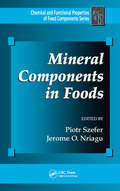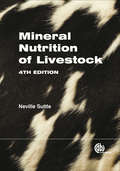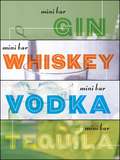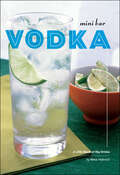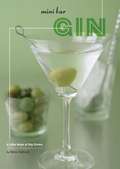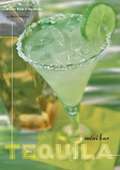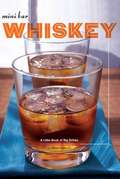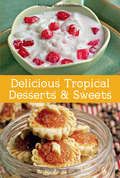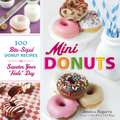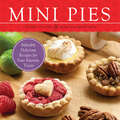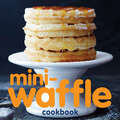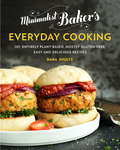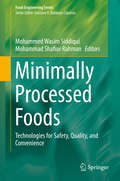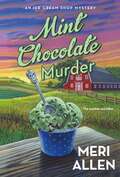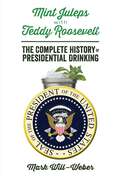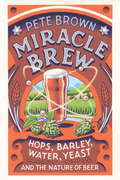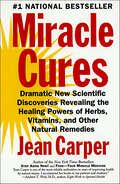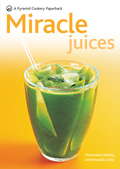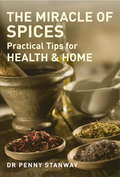- Table View
- List View
Mineral Components in Foods
by Piotr Szefer Jerome O. NriaguRecent studies have raised concerns about the health effects of dietary exposure to trace elements. An estimated 40 percent of the world's population suffers from developmental and metabolic functional disorders due to trace element deficiencies. Conversely, there is an established link between excess intake of mineral components and diseases of th
Mineral Nutrition of Livestock (4th edition)
by Neville F. SuttleSuttle (Moredun Foundation, Britain) updates the detailed reference for veterinarians and keepers of livestock to incorporate findings from the past decade. His goal is to find a useful middle ground between basic science that looks at nutrition on a cellular or molecular level, and studies that are thinly disguised advertisements for commercial products. He discusses the requirements for minerals, natural sources of minerals, assessing and controlling mineral status in livestock, a number of specific minerals such as potassium and iodine, occasionally beneficial elements, potentially toxic elements, the design of supplementation trials for assessing mineral deprivation, and minerals and humans.
Mini Bar Bundle
by Mittie Hellmich Frankie Frankeny Laura StojanovicA must-have for any weekend bartender or mixologist! This bundle of four great cocktail books spans the entire Mini Bar series and includes: Vodka, Whiskey, Rum, and Tequila. Each is filled with more than 50 traditional and original recipes that pack a punch. Find recipes for a Traditional Southern-Style Mint Julep, the Perfect Manhattan, a Fig Leaf Fizz, a sophisticated Martini, and even a Frozen Watermelon Daiquiri. Each title in this bundle describes the history and distinct characteristics of its particular alcohol.
Mini Bar Vodka: A Little Book of Big Drinks
by Mittie HellmichThe Mini Bar series maybe small in size, but each tiny tome is filled with classic and original recipes that pack quite a wallop! Vodka enthusiasts will find delightful concoctions covering everything from the sophisticated Martini to the festive Fig Leaf Fizz. Each volume in this new series tells the history of its particular alcohol, as well as its distinct traits and characteristics. A glossary of essential bar tools and cocktail terminology will ensure readers not only walk the walk of an expert mixologist, but also talk the talk. With more than 50 delicious recipes, this little cocktail book makes a spirited stocking stuffer or great gift.
Mini Bar: Gin
by Mittie Hellmich Frankie FrankenyDon't let the small size fool you--each volume in the Mini Bar series is filled with more than 50 traditional and original recipes that pack a punch. Gin aficionados will toast concoctions like the Tasmanian Twister. Each title in this series describes the history and distinct characteristics of its particular alcohol. Small enough to carry on a tropical vacation or stash next to the blender, these little cocktail books are a must-have for the weekend bartender.
Mini Bar: Rum
by Mittie Hellmich Frankie FrankenyEach volume in the Mini Bar series is filled with more than 50 traditional and original recipes that pack a punch. Rum lovers will break out the little umbrellas for Mittie's innovative Frozen Watermelon Daiquiri and Colada Nueva. Each title in this series describes the history and distinct characteristics of its particular alcohol. Small enough to carry on a tropical vacation or stash next to the blender, these little cocktail books are a must-have for the weekend bartender.
Mini Bar: Tequila
by Mittie Hellmich Frankie FrankenyDon't let the small size fool you--each volume in the Mini Bar series is filled with more than 50 traditional and original recipes that pack a punch. Tequila tipplers will love the agave-alicious Papaya Margarita and Tequila Sunrise. Each title in this series describes the history and distinct characteristics of its particular alcohol. Small enough to carry on a tropical vacation or stash next to the blender, these little cocktail books are a must-have for the weekend bartender.
Mini Bar: Whiskey
by Mittie Hellmich Laura StojanovicThe Mini Bar series maybe small in size, but each tiny tome is filled with classic and original recipes that pack quite a wallop! Whiskey lovers will find everything from the Perfect Manhattan to the Traditional Southern-Style Mint Julep. Each volume in this new series tells the history of its particular alcohol, as well as its distinct traits and characteristics. A glossary of essential bar tools and cocktail terminology will ensure readers not only walk the walk of an expert mixologist, but also talk the talk. With more than 50 delicious recipes, this little cocktail book makes a spirited stocking stuffer or great gift.
Mini Cupcakes
by Leslie FietFrom the owner of Mini&’s Cupcakes in Salt Lake City, a guide to making, baking, and decorating some tiny yet tasty cupcakes. Mini Cupcakes specifies the finest ingredients, including Madagascar vanilla, dark Belgium chocolate, and organic fruits to create amazing mini cupcake creations. Combine great cake recipes, such as Key Largo Lime or Chocoholic, with filling recipes, such as banana cream or salted caramel. Add frosting and toppings such as white chocolate ganache or margarita cream cheese and you have endless combinations of rich and decadent goodness. With tips for making, baking, and decorating, this cookbook offers perfect combinations, from the Breakfast at Tiffany's cupcake to Pretty in Pink, from the Diva cupcake to the Mocha Latte. Part delicious cupcake, part tiny pieces of art, mini cupcakes are the perfect treat to satisfy your cravings or entertain in style.
Mini Delicious Tropical Desserts & Sweets
by Devagi SanmuganCelebrity chef, cookbook author, food columnist, cooking instructor and entrepreneur, Devagi Sanmugam is one of Singapore's most dynamic and talented food personalities. Starting as a cooking instructor more than 20 years ago, Devagi has since built an impressive portfolio including writing more than a dozen cookbooks. She continues to innovate, being constantly involved in developing and testing original recipes for food companies, restaurants and magazines. Widely known as the Spice Queen of Singapore, Devagi has also hosted a number of television cooking shows for local and foreign media.Delicious Tropical Desserts & Sweets brings you an exciting collection of the most popular tropical desserts-like Chendol, Thai Red Rubies, Pineapple Tarts and Vanilla Gelato.
Mini Donuts
by Jessica SegarraSay hello to a brand-new way to brighten your morning--or any time of day! Jam-packed with gooey jellies, oozing with rich custards and creams, and covered with mouthwatering toppings, these mini donuts are bursting with big flavor. From recipes for the traditional donuts everyone craves like Chocolate Cake and Powered Sugar to fun, new twists like Chocolate-Bacon-Maple, the donuts in this cookbook will leave you begging for more than just a dozen. Best of all, almost all the recipes can be made in a mini donut maker appliance, a stovetop, or an oven, so all you'll need to create these bite-sized snacks is a hankering for something sweet. Inside this cookbook, you'll find helpful step-by-step instructions and 100 yummy donut recipes, including: Maple-glazed White chocolate-red velvet Pineapple upside-down cake Butterscotch-banana Chai tea S'mores With Mini Donuts, you'll never again have to wait in line for your favorite bakery treat!
Mini Donuts
by Jessica SegarraSay hello to a brand-new way to brighten your morning--or any time of day! Jam-packed with gooey jellies, oozing with rich custards and creams, and covered with mouthwatering toppings, these mini donuts are bursting with big flavor. From recipes for the traditional donuts everyone craves like Chocolate Cake and Powered Sugar to fun, new twists like Chocolate-Bacon-Maple, the donuts in this cookbook will leave you begging for more than just a dozen. Best of all, almost all the recipes can be made in a mini donut maker appliance, a stovetop, or an oven, so all you'll need to create these bite-sized snacks is a hankering for something sweet. Inside this cookbook, you'll find helpful step-by-step instructions and 100 yummy donut recipes, including: Maple-glazed White chocolate-red velvet Pineapple upside-down cake Butterscotch-banana Chai tea S'mores With Mini Donuts, you'll never again have to wait in line for your favorite bakery treat!
Mini Donuts: 100 Bite-Sized Donut Recipes to Sweeten Your "Hole" Day
by Jessica SegarraSay hello to a brand-new way to brighten your morning—or any time of day! Jam-packed with gooey jellies, oozing with rich custards and creams, and covered with mouthwatering toppings, these mini donuts are bursting with big flavor. From recipes for the traditional donuts everyone craves like Chocolate Cake and Powered Sugar to fun, new twists like Chocolate-Bacon-Maple, the donuts in this cookbook will leave you begging for more than just a dozen. Best of all, almost all the recipes can be made in a mini donut maker appliance, a stovetop, or an oven, so all you'll need to create these bite-sized snacks is a hankering for something sweet.Inside this cookbook, you'll find helpful step-by-step instructions and 100 yummy donut recipes, including:Maple-glazedWhite chocolate–red velvetPineapple upside-down cakeButterscotch-bananaChai teaS'mores With Mini Donuts, you'll never again have to wait in line for your favorite bakery treat!
Mini Pies: Adorable and Delicious Recipes for Your Favorite Treats
by Morgan Greenseth Christy BeaverDiscover the joy of crafting small, single-serving and handheld pies hot from the oven with this adorable collection of sweet and savory recipes.The flaky crust and delectable filling of traditional pie in the ultimate grab-and-go, fun-sized desserts—mini pies! Do you love the taste of pie but prefer the cute size of a cupcake? Then toss the pie pan, grab your muffin tin and open this book. With delicious recipes, easy-to-follow instructions and stunning color photographs, Mini Pies provides everything you need to bake these adorable miniature desserts with professional results.Featuring gourmet recipes for a range of fruit, custard, nut and savory delights, Mini Pies serves up hold in-your-hand, single-serving versions of all your favorites, as well as the authors’ all-new creations, including:•Apple• Cherry• Strawberry• Pumpkin• Key Lime• Lemon Meringue• Chocolate Cream• Bourbon Pecan• Honey and Pine Nut• Dilled Spinach Quiche• Onion, Olive and Thyme TartWhether you are baking a single batch to have around the house for your family or making a collection of different mini pies to offer guests at your next party, this book is packed with tips, tricks and techniques for creating crowd-pleasing mini pies. The authors guide you step-by-step through making the perfect crust, plus graham cracker, vegan, shortbread and gluten-free variations.“The cupcake is dead. Long live the pie!”—NPR's Weekend Edition
Mini Rice Cooker Cookbook
by Lynda BalslevDiscover how to cook breakfast, soups & stews, salads & bowls, entrées, and desserts with this collection of recipes for your mini rice cooker.Looking for a fast dinner, dessert, or a tasty snack, the Mini Rice Cooker Cookbook has something for you. Forget your Crock-Pot, the bright-colored mini rice cooker is your new easy-to-use, easy-to-cook solution for everything from eggs to pad thai to chocolate cake.The perfect complement to your new appliance, the Mini Rice Cooker Cookbook has fresh ideas for every occasion, from breakfast to dessert. A mini rice cooker is perfect for cramped college dorms, small apartments, even RVs. You don’t need extra kitchen tools like pots and pans for these recipes. Offering vegetarian, vegan, or gluten-free variations, the recipes in this cookbook are sure to stretch your imagination for what a rice cooker can do. Recipes include pasta, soup, stew, beans, grains, cakes, breads, and more.
Mini-Waffle Cookbook
by Andrews McMeel PublishingAn indispensable guide to the trendy squares that can be paired with fried eggs, melted cheese, sandwich fixings, meaty burgers, fresh fruit, and more.Thanks to the advent of the mini waffle maker, these sweet and savory treats are all the rage. The perfect complement to your new appliance, the Mini-Waffle Cookbook has fresh ideas for every occasion, from breakfast to dessert. You’ll find basic recipes for Belgian, gluten-free, vegan, Banana Walnut Waffles, and more! Waffles are not just for breakfast, and once you master these easy basic recipes you can use them in myriad other recipes such as a Fritaffle, Waffle-Blini, Waffled Panini, Waffled Calzone, Waffle Joe, Strawberry Shortcake Waffles, and Waffle Pops.
Minimalist Baker's Everyday Cooking: 101 Entirely Plant-based, Mostly Gluten-Free, Easy and Delicious Recipes
by Dana ShultzThe highly anticipated cookbook from the immensely popular food blog Minimalist Baker, featuring 101 all-new simple, vegan recipes that all require 10 ingredients or less, 1 bowl or 1 pot, or 30 minutes or less to prepare Dana Shultz founded the Minimalist Baker blog in 2012 to share her passion for simple cooking and quickly gained a devoted worldwide following. Now, in this long-awaited debut cookbook, Dana shares 101 vibrant, simple recipes that are entirely plant-based, mostly gluten-free, and 100% delicious. Packed with gorgeous photography, this practical but inspiring cookbook includes: * Recipes that each require 10 ingredients or less, can be made in one bowl, or require 30 minutes or less to prepare. * Delicious options for hearty entrées, easy sides, nourishing breakfasts, and decadent desserts--all on the table in a snap * Essential plant-based pantry and equipment tips * Easy-to-follow, step-by-step recipes with standard and metric ingredient measurements Minimalist Baker's Everyday Cooking is a totally no-fuss approach to cooking for anyone who loves delicious food that happens to be healthy too. From the Hardcover edition.
Minimally Processed Foods
by Mohammed Wasim Siddiqui Mohammad Shafiur RahmanThe safety and efficacy of minimal food processing depends on the use of novel preservation technologies. This book first examines what is meant by minimally processed foods, including fresh-cut, cooked-chilled, and part-baked products. Next explored are the technologies or methods to produce quality products in terms of safety and nutrition, including: edible coating, natural preservatives (i. e. , antimicrobial, flavour enhancer, anti-browning), advanced packaging (active, antimicrobial, and modified or controlled atmosphere), and selected non-thermal techniques (high pressure, pulsed electric field, ultrasound, light). Preservation of food is crucial to achieving a secure and safe global food supply with the desired sensory quality. In addition, the increasing consumer demand for safe, ready-to-serve, ready-to-eat-and-cook products with minimal chemical preservatives has raised expectations. However, foods deemed minimally processed, such as fresh-cut fruits and vegetables, cooked-chilled, and half-baked foods, are delicate products that need special care in preparation, processing, storage, and handling. As a result, new technologies to develop minimally processed foods have aggressively advanced. Minimally Processed Foods: Technologies for Safety, Quality, and Convenience explores both the definition of minimally processed foods and the methods and technologies used to achieve the safety and nutritional value consumers demand. About the Editors Mohammed Wasim Siddiqui, Bihar Agricultural University, Sabour, Bhagalpur, India Mohammad Shafiur Rahman, Sultan Qaboos University, Al-khod, Oman
Mint Chocolate Murder: An Ice Cream Shop Mystery (Ice Cream Shop Mysteries #2)
by Meri Allen"Mint Chocolate Murder is a delightful confection of wonderful characters, a yummy setting, and an intriguing, twisty, and multi-layered mystery. It's the perfect book to curl up with on a lazy summer afternoon—preferably with your favorite flavor of ice cream close to hand." --Elizabeth Penney, Edgar-nominated author of the Cambridge Bookshop SeriesRiley Rhodes returns in the second delicious cozy set in a New England ice cream shop, Meri Allen's Mint Chocolate Murder!When Udderly Delightful Ice Cream shop manager Riley Rhodes is summoned to Penniman’s Moy Mull Castle, it’s the cherry on top of a successful summer season. The gothic pile built by an eccentric New England Gilded Age millionaire has been transformed into a premiere arts colony by Maud Monaco, a reclusive former supermodel. As part of Moy Mull’s Fall Arts Festival, Maud is throwing a fantasy ice cream social and hires Riley to whip up unique treats to celebrate the opening of an exhibit by Adam Blasco, a photographer as obnoxious as he is talented.As Penniman fills up with Maud’s art-world friends arriving for the festival, gossip swirls around Blasco, who has a dark history of obsession with his models. Riley’s curiosity and instincts for sleuthing – she was a CIA librarian – are piqued, and she wonders at the hold the cold-hearted photographer has over the mistress of Moy Mull.But when Adam is found dead behind the locked door of Moy Mull’s dungeon, Riley realizes there’s more than one suspect who’d wanted to put the malicious photographer on ice.
Mint Juleps with Teddy Roosevelt: The Complete History of Presidential Drinking
by Mark Will-WeberIn the more than two-hundred-year history of the American presidency, there has been one element present in each and every administration: alcohol.In the beginning, there was George Washington, who sold whiskey distilled at Mount Vernon and preferred to quaff a well-crafted port. More than two hundred years later, Barack Obama beckoned some master brewers to advise his White House staff on how to make mouth-watering batches of White House Honey Ale with a key ingredient from Michelle Obama's beehives.And then there was the matter of the forty-two other gentlemen in between...Journalist Mark Will-Weber strolls through our country's memorable moments--from the Founding Fathers to the days of Prohibition, from impeachment hearings to diplomatic negotiations--and the role that a good stiff drink played in them in his new book, Mint Juleps with Teddy Roosevelt: The Complete History of Presidential Drinking.So grab a cocktail and turn the pages of Mint Juleps with Teddy Roosevelt for a unique and entertaining look into the liquor cabinets and the beer refrigerators of the White House. Cheers!
Miracle Brew: Hops, Barley, Water, Yeast and the Nature of Beer
by Pete BrownMost people know that wine is created by fermenting pressed grape juice and cider by pressing apples. But although it’s the most popular alcoholic drink on the planet, few people know what beer is made of. In lively and witty fashion, Miracle Brew dives into traditional beer’s four natural ingredients: malted barley, hops, yeast, and water, each of which has an incredible story to tell. From the Lambic breweries of Belgium, where beer is fermented with wild yeasts drawn down from the air around the brewery, to the aquifers below Burton-on-Trent, where the brewing water is rumored to contain life-giving qualities, Miracle Brew tells the full story behind the amazing role each of these fantastic four—a grass, a weed, a fungus, and water—has to play. Celebrated U.K. beer writer Pete Brown travels from the surreal madness of drink-sodden hop-blessings in the Czech Republic to Bamberg in the heart of Bavaria, where malt smoked over an open flame creates beer that tastes like liquid bacon. He explores the origins of fermentation, the lost age of hallucinogenic gruit beers, and the evolution of modern hop varieties that now challenge wine grapes in the extent to which they are discussed and revered. Along the way, readers will meet and drink with a cast of characters who reveal the magic of beer and celebrate the joy of drinking it. And almost without noticing we’ll learn the naked truth about the world’s greatest beverage.
Miracle Cures: Dramatic New Scientific Discoveries Revealing the Healing Powers of Herbs, Vitamins, and Other Natural Remedies
by Jean CarperFrom Jean Carper, America's Most Trusted Source of Cutting-Edge Nutritional Advice, the Bestselling Guide to the Dramatic Healing Powers of Herbs, Vitamins, and Other Natural RemediesMiracle Cures is the breakthrough book that presents scientific evidence of the effectiveness of natural remedies, culled from the world's leading doctors and scientists, research centers, and major international scientific journals, including the Journal of the American Medical Association and the British Medical Journal, combined with the awe-inspiring first-person medically verified accounts of people who have successfully cured themselves with natural medicines. Jean Carper Reveals the Natural Medicines That Have Been Proven to: Lower Your Cholesterol Open up Your Arteries Regulate Your Heart Relieve Depression Overcome Anxiety Fight Sleep Problems Regenerate Your Liver Restore Your Memory
Miracle Juices (Pyramids)
by Amanda Cross Charmaine YabsleyMiracle Juices contains over 40 nutritious juices recommended to combat specific ailments such as asthma and high blood pressure. Quick and easy to prepare, each juice is guaranteed to boost health and vitality. With nutritional analysis for every recipe, detailing the vitamin, mineral and calorie content of your chosen beverage, you can be sure that each miracle juice is helping to maintain a balanced and healthy diet.
Miracle of Spices
by Penny StanwayThe Miracle of Spices is a comprehensive guide that offers a wealth of information and ingenious practical tips on the many health, beauty and culinary benefits to be gained from using spices readily available in your local supermarket. The book opens with a short history of spices, their popularity around the world over the millennia and their value to world trade. The first chapter outlines the sources, names, contents, aroma, flavour and culinary uses of the 50 most used spices. The remaining chapters address topics such as the best ways to buy, choose, store and use spices; how to help to prevent and treat common ailments with spices; and how to make use of them in your home. Finally, there's a substantial selection of some of the most delicious spice-containing recipes to inspire and delight.
Miracle of Spices
by Penny StanwayThe Miracle of Spices is a comprehensive guide that offers a wealth of information and ingenious practical tips on the many health, beauty and culinary benefits to be gained from using spices readily available in your local supermarket. The book opens with a short history of spices, their popularity around the world over the millennia and their value to world trade. The first chapter outlines the sources, names, contents, aroma, flavour and culinary uses of the 50 most used spices. The remaining chapters address topics such as the best ways to buy, choose, store and use spices; how to help to prevent and treat common ailments with spices; and how to make use of them in your home. Finally, there's a substantial selection of some of the most delicious spice-containing recipes to inspire and delight.
